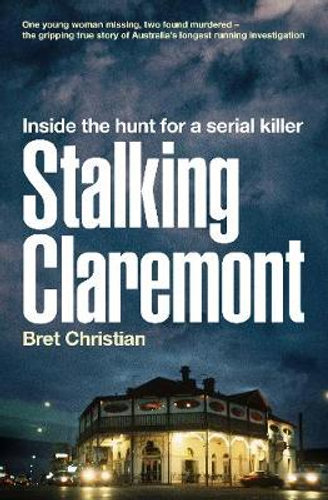Bret Christian has been a newsman all his working life, beginning his career on the Perth Daily News, and working in Melbourne and Sydney before returning to Perth to start his own suburban Post Newspapers group at the age of twenty-eight. By coincidence the territories his newspapers service were the hunting grounds for three separate serial killers, fuelling his interest in this mysterious human act of evil. His search for answers led him to unearth many extraordinary injustices, some of which he helped put right. He is still a reporter and his latest book is called Stalking Claremont: Inside the hunt for a serial killer.
Today, Bret Christian is on the blog to answer a few of our questions about Stalking Claremont. Read on …
Tell us about your book, Stalking Claremont: Inside the hunt for a serial killer.
BC: The heart of the book is four carefree young women who, like thousands of others, were enjoying a night out in one location. Their nights ended terribly for them after they were abducted by a stranger. This book traces the saga that began with that first abduction, with three more over the next two-and-a-half years. It looks inside the lives of the victims and their families, inside the extraordinary police investigation, revealing jaw-dropping details for the first time. It does not shy away from the mistakes and wrong decisions that dogged the manhunt, and the devastating effects on the lives of wrong suspects targeted by police. In a final twist that no-one saw coming, the book reveals the extraordinary events leading to the arrest for murder of a community-minded man living among us in plain sight.
What drew you to this particular story and made you want to write a book about it?
BC: I live and work near the centre of what became a disaster area. I know many of the people affected by these crimes. I edit and write for the local newspaper that circulates in the area. It was a compelling story but also a deeply personal one. It had dominated all our lives for 25 years. While the story unfolds as a thriller, it cried out for a definitive book on the case because of the intense nation-wide public interest and the lessons that can be learned.
The hunt to find the serial killer in this case has been described as one of the longest and most expensive investigations in Australian history. Why is that?
BC: The killer was very lucky. A series of sometimes amazing events during the manhunt conspired to keep him out of the clutches of the law. Focus on the wrong suspects distracted police for many years. The real culprit, seeing news reports of the intense police interest in the wrong people, knew he could relax. The longer the killer went without capture, the more confident he became that he would never be located.
Without giving too much away, what surprised you the most while investigating this story?
BC: How well secrecy of the investigation held. It became clear during my research that had the police taken the public into their confidence, rather than keep their cards close to their chest, the crimes could possibly have been solved much sooner.
What has been the effect of this ongoing investigation on the suburb of Claremont over the last 20 years?
BC: It has been very traumatic for a lot of men, and in some cases their families. Men who were in Claremont on the nights the young women disappeared and who had no alibis were visited by detectives and intensely questioned and DNA tested. In some cases their homes were searched from top to bottom. Friends of the abducted women were drawn into the investigation and had to re-live the nineties in court during 2020.
You began a local news outlet, Post Newspapers, at quite a young age. What do you think is the value of a local news source when it comes to covering these kinds of stories, compared to a bigger news outlet?
BC: As the local newspaper, we are closest to the people. We know a lot of local people, some very significant to the investigation. Our 80,000 readers trust us. In many instances they called us with information they were not prepared to give to the police. As a result, the Post was able to break a lot of news stories that other media outlets could not. Our reports were frequently followed up by state and national media.
Do you read much from the true crime genre yourself?
BC: I read around 250 true crime, memoirs and academic books while researching Stalking Claremont and my previous true crime book, Presumed Guilty: When cops get it wrongs and courts seal the deal.
Is there anything that you think police investigators can learn from this case?
BC: A successful tactic can be to take the community into their confidence at an early stage when memories are fresh. Don’t rely on gut feelings about suspects – suspicion must always be backed up by physical evidence. But the book is not by any means all critical. It celebrates some excellent police work by clever hard-working officers and scientists – what the Police Commissioner Dr Karl O’Callaghan called the police service’s finest hour.
What do you hope readers will discover in Stalking Claremont?
BC: Insight.
And finally, what’s up next for you?
BC: Surf and fishing.
Thanks Bret!
—Stalking Claremont: Inside the hunt for a serial killer (HarperCollins Australia) is out now.

Stalking Claremont
Inside the hunt for a serial killer
The gripping true story of the notorious Claremont serial murders and the nation's longest and most expensive investigation to catch the killer
In the early hours of January 27, 1996, after an evening spent celebrating at Club Bayview in the Perth suburb of Claremont, 18-year-old Sarah Spiers called a taxi to nearby Mosman Park. But when the cab arrived, she'd already gone. Sarah was never seen again. Four months later, on June 9, 1996, 23-year-old Jane Rimmer disappeared from the same...







 What do we know about the Boy Swallows Universe Netflix show?
What do we know about the Boy Swallows Universe Netflix show?  Booktopia’s top thrilling fiction picks for Crime Month
Booktopia’s top thrilling fiction picks for Crime Month  Booktopia’s Top First Nations Book Recommendations for 2023
Booktopia’s Top First Nations Book Recommendations for 2023
Comments
January 24, 2021 at 9:23 pm
Stalking Claremont mentioned that Ciara Glennon’s body was found “near an area where Telecom / Telstra had been working” thus giving the impression that Edwards had perhaps been working locally and thus gained the knowledge of the area. Had he also worked in the Wellard area before he killed Jane Rimmer ?? Had Police ever given consideration to this – and therefore had they given consideration to what other “remote” areas had been his work sites prior to the disappearance of Sarah Spiers. If there had been maybe a handful, or 20 or 30 such locations, surely those locations would have been worth a search, especially given how poorly Ciara and Jane were hidden.